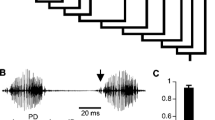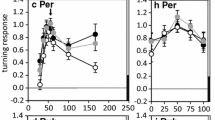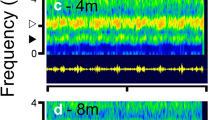Summary
-
1.
The hypothesis that a sound must be both localizable and recognizable for positive phonotaxis towards this sound to occur was tested in Gryllus bimaculatus.
-
2.
Tethered females were allowed to walk on a non-compensating treadmill. Songs were played from two loudspeakers, one positioned to the side and another positioned directly above the cricket, so crickets could localize sounds from the side but not from the top speaker.
-
3.
Calling song chirps with an ineffective pulse (syllable) period were first played from the side speaker. These chirps failed to elicit positive phonotaxis. When these ineffective chirps were interleaved with top speaker playbacks of chirps that had an appropriate pulse period, females began to walk toward the side speaker. So it is not necessary for a sound to be both localized and recognized (re: pulse period) for positive phonotaxis to this sound to occur.
-
4.
Additional experiments were run to test how chirp rhythm affected phono taxis. Ineffective (slow) chirps played from the side speaker failed to elicit phonotaxis. However, phonotaxis was elicited when these slow, ineffective chirps were interleaved with tone bursts played from the top speaker. This further demonstrates the importance of the interaction of calling song temporal properties in eliciting phonotaxis.
Similar content being viewed by others
References
Atkins S, Atkins G, Rhodes M, Stout JF (1989) Influence of syllable period on song encoding properties of an ascending auditory interneuron in the cricket Acheta domestica. J Comp Physiol A 165:827–836
Doherty JA (1985a) Temperature coupling and trade-off phenomena in the acoustic communication system of the cricket, Gryllus bimaculatus DeGeer. J Exp Biol 114:17–35
Doherty JA (1985b) Trade-off phenomena in calling song recognition and phonotaxis in the cricket, Gryllus bimaculatus DeGeer. J Comp Physiol A 156:787–801
Doherty JA (1985c) Phonotaxis in the cricket, Gryllus bimaculatus DeGeer: comparisons of choice and no-choice paradigms. J Comp Physiol A 157:279–289
Doherty JA, Hoy RR (1985) Communication in insects. III. The auditory behavior of crickets: Some views of genetic coupling, song recognition, and predator detection. Q Rev Biol 60:457–471
Doherty JA, Pires A (1987) A new microcomputer-based method for measuring walking phonotaxis in field crickets (Gryllidae). J Exp Biol 130:425–432
Doolan JM, Pollack GS (1985) Phonotactic specificity of the cricket Teleogryllus oceanicus: intensity-dependent selectivity for temporal parameters of the stimulus. J Comp Physiol A 157:223–233
Heiversen D von (1984) Parallel processing in auditory pattern recognition and directional analysis by the grasshopper Chorthippus biguttulus L. (Acrididae). J Comp Physiol A 154:837–846
Hill KG (1974) Acoustic communication in the Australian field crickets Teleogryllus commodus and T. oceanicus (Orthoptera, Gryllidae). Thesis, University of Melbourne
Huber F, Thorson J (1985) Cricket auditory communication. Sci Am 253:60–68
Huber F, Kleindienst H-U, Weber T, Thorson J (1984) Auditory behavior of the cricket. III. Tracking of male calling song by surgically and developmentally one-eared females, and the curious role of the anterior tympanum. J Comp Physiol A 155:725–738
Kramer E (1976) The orientation of walking honeybees in odour fields with small concentration gradients. Physiol Entomol 1:27–37
Pollack GS (1986) Discrimination of calling song models by the cricket, Teleogryllus oceanicus: the influence of sound direction on neural encoding of the stimulus temporal pattern and on phonotactic behavior. J Comp Physiol A 158:549–561
Pollack GS (1988) Selective attention in an insect auditory neuron. J Neurosci 8:2635–2639
Schildberger K (1984) Temporal selectivity of identified auditory neurons in the cricket brain. J Comp Physiol A 155:171–185
Schildberger K (1985) Recognition of temporal patterns by identified auditory neurons in the cricket brain. In: Kalmring K, Elsner N (eds) Acoustic and vibrational communication in insects. Berlin, Parey, pp 41–49
Schildberger K (1988) Behavior and neuronal mechanisms of cricket phono taxis. Experientia 44:408–415
Schildberger K, Hörner M (1988) The function of auditory neurons in cricket phonotaxis. I. Influence of hyperpolarization of identified neurons on sound localization. J Comp Physiol A 163:621–631
Schmilz B (1983) Analyse der akustischen Orientierung bei Grillenweibchen (Gryllus campestris L.). Dissertation, Köln, FRG
Stabel J, Wendler G, Scharstein H (1989) Cricket phonotaxis: localization depends on recognition of the calling song pattern. J Comp Physiol A 165:165–177
Stout JF, McGhee R (1988) Attractiveness of the male Acheta domestica calling song to females. II. The relative importance of syllable period, intensity, and chirp rate. J Comp Physiol A 164:277–287
Stout JF, DeHaan CH, McGhee RW (1983) Attractiveness of the male Acheta domestica calling song to females. I. Dependence on each of the calling song features. J Comp Physiol A 153:509–521
Thorson J, Weber T, Huber F (1982) Auditory behavior of the cricket. II. Simplicity of calling-song recognition in Gryllus, and anomalous phonotaxis at abnormal carrier frequencies. J Comp Physiol 146:361–378
Weber TH (1984) Acoustic pattern recognition in crickets. In: Varju D, Schnitzler HU (eds) Localization and orientation in biology and engeneering. Springer, Berlin Heidelberg New York, pp 181–185
Weber T, Thorson J (1988) Auditory behavior of the cricket. IV. Interaction of direction of tracking with perceived temporal pattern in split-song paradigms. J Comp Physiol A 163:13–22
Weber T, Thorson J, Huber F (1981) Auditory behavior of the cricket. I. Dynamics of compensated walking and discrimination paradigms on the Kramer treadmill. J Comp Physiol 141:215–232
Wendler G (1989) Acoustic orientation of crickets (Gryllus campestris) in the presence of two sound sources. Naturwissenschaften 76:128–129
Author information
Authors and Affiliations
Rights and permissions
About this article
Cite this article
Doherty, J.A. Song recognition and localization in the phonotaxis behavior of the field cricket, Gryllus bimaculatus (Orthoptera: Gryllidae). J Comp Physiol A 168, 213–222 (1991). https://doi.org/10.1007/BF00218413
Accepted:
Issue Date:
DOI: https://doi.org/10.1007/BF00218413




